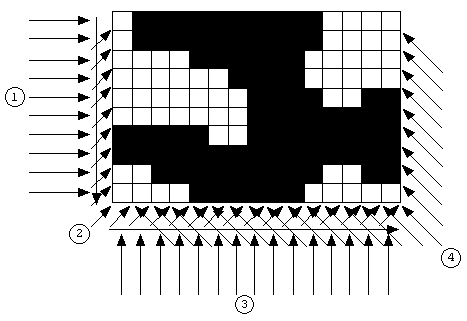Not an official ACM page
[1993 ACM finals problem set
| My ACM problem archive
| my home page]
1993 ACM Scholastic Programming Contest Finals
sponsored by AT&T EasyLink Services
Problem H
Scanner
A body scanner works by scanning a succession of horizontal slices
through the body; the slices are imaged one at a time. The image
slices can be reassembled to form a three dimensional model of the
object. Write a program to construct a two dimensional image slice
using data captured during the scan.

The scanner consists of four arrays of sensors arranged around a 10x15
matrix. Array 1 consists of 10 sensors pointing to the right, array 2
has 24 sensors pointing diagonally to the top right, array 3 has 15
sensors pointing to the top and array 4 has 24 sensors pointing to the
top left. Each sensor records the thickness of that portion of the
object directly in front of that sensor.
Readings from the arrays of sensors are recorded in counterclockwise
order. Within an array of sensors, data are also recorded
counterclockwise. A complete scan consists of 73 readings.
Input
The input file begins with a line with an integer indicating the
number of image slices to follow. For each image slice, there are
separate lines with 10, 24, 15, and 24 integers representing sensor
data from sensor arrays 1 through 4 respectively. The order of the
readings is indicated in the diagram. Although it is possible for the
result of a scan to be ambiguous, the data supplied to you will have
no ambiguous interpretation.
Output
For each slice, your program should print 10 lines of 15 cells. To indicate that the cell represents a part of the
object, print a hash character (#) for the cell; to indicate that the cell is not a part of the object, print a period (.).
Between successive output image slices, print a blank line.
Sample Input (describing object in diagram above)
1
10 10 6 4 6 8 13 15 11 6
0 1 2 2 2 2 4 5 5 6 7 6 5 6 6 5 5 6 6 3 2 2 1 0
2 4 5 5 7 6 7 10 10 10 7 3 3 5 5
0 0 1 3 4 4 4 4 3 4 5 7 8 8 9 9 6 4 4 2 0 0 0 0
Output for the Sample Input
.##########....
.##########....
....######.....
......####.....
.......####..##
.......########
#####..########
###############
..#########..##
....######.....
This page maintained by Ed Karrels

Last updated February 12, 2010

